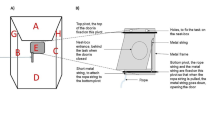Abstract
Previous laboratory studies on social learning suggest that some animals can learn more readily if they first observe a conspecific demonstrator perform the task unsuccessfully and so fail to obtain a food reward than if they observe a successful demonstrator that obtains the food. This effect may indicate a difference in how easily animals are able to associate different outcomes with the conspecific or could simply be the result of having food present in only some of the demonstrations. To investigate we tested a scatter-hoarding mammal, the eastern grey squirrel, on its ability to learn to choose between two pots of food after watching a conspecific remove a nut from one of them on every trial. Squirrels that were rewarded for choosing the opposite pot to the conspecific chose correctly more frequently than squirrels rewarded for choosing the same pot (a feature-negative effect). Another group of squirrels was tested on their ability to choose between the two pots when the rewarded option was indicated by a piece of card. This time, squirrels showed no significant difference in their ability to learn to choose the same or the opposite pot. The results add to anecdotal reports that grey squirrels can learn by observing a conspecific and suggest that even when all subjects are provided with demonstrations with the same content, not all learning occurs equally. Prior experience or expectations of the association between a cue (a conspecific) and food influences what can be learned through observation whilst previously unfamiliar cues (the card) can be associated more readily with any outcome.



Similar content being viewed by others
References
Bednekoff PA, Balda RP (1996) Observational spatial memory in Clark’s nutcrackers and Mexican jays. Anim Behav 52:833–839
Coolen I, Ward AJW, Hart PJB, Laland KN (2005) Foraging nine-spined sticklebacks prefer to rely on public information over simpler social cues. Behav Ecol 16:865–870
Dally JM, Clayton NS, Emery NJ (2006) The behaviour and evolution of cache protection and pilferage. Anim Behav 72:13–23
Daly M, Jacobs LF, Wilson MI, Behrends PR (1992) Scatter hoarding kangaroo rats (Dipodomys merriami) and pilferage from their caches. Behav Ecol 3:102–111
Darby CL, Riopelle AJ (1959) Observational learning in the rhesus monkey. J Comp Physiol Psychol 52:94–98
Dittrich WH, Lea SEG (1993) Motion as a natural category for pigeons: generalization and a feature-positive effect. J Exp Anal Behav 59:115–129
Galef BG, Giraldeau L-A (2001) Social influences on foraging in vertebrates: causal mechanisms and adaptive functions. Anim Behav 61:3–15
Giraldeau L-A, Valone TJ, Templeton JJ (2002) Potential disadvantages of using socially acquired information. Philos Trans R Soc B 357:1559–1566
Haggbloom SJ (1983) Feature-negative effect in rats’ discrimination learning in the runway. Anim Learn Behav 11:367–372
Haggbloom SJ, Sheppard FK (1986) Feature-negative effect in serial learning. Bull Psychon Soc 24:217–218
Heyes CM (1994) Social learning in animals: categories and mechanisms. Biol Rev 69:207–231
Hopewell LJ, Leaver LA (2008) Evidence of social influences on cache-making by grey squirrels (Sciurus carolinensis). Ethology 114:1061–1068
Jenkins HM, Sainsbury RS (1970) Discrimination learning with the distinctive feature on positive or negative trials. In: Mostofsky D (ed) Attention: contemporary theory and analysis. Appleton-Century-Crofts, New York, pp 239–273
Jolly A (1966) Lemur social behaviour and primate intelligence. Science 153:501–506
Leaver LA, Hopewell LJ, Caldwell CA, Mallarky L (2007) Audience effects on food caching in grey squirrels (Sciurus carolinensis): evidence for pilferage avoidance strategies. Anim Cogn 10:23–27
Looney TA, Griffin RW (1978) A sequential feature-positive effect using tone as the distinguishing feature in an autoshaping procedure. Anim Learn Behav 6:401–405
Pallaud B, Lepoivre H (1985) Apprentissage d’inversion dans une situation de discrimination spatiale par un groupe de babouines: interactions entre facteurs cognitifs and facteurs sociaux. Cah Psychol Cogn 5:527–551
Sainsbury RS (1971a) Effect of proximity of elements on the feature positive effect. J Exp Anal Behav 16:315–325
Sainsbury RS (1971b) The ‘feature positive effect’ and simultaneous discrimination learning. J Exp Child Psychol 11:347–356
Sainsbury RS (1973) Discrimination learning utilizing positive or negative cues. Can J Psychol 27:46–57
Seligman MEP (1970) On the generality of the laws of learning. Psychol Rev 77:406–418
Steele MA, Halkin SL, Smallwood PD, McKenna TJ, Mitsopoulos K, Beam M (2008) Cache protection strategies of a scatter-hoarding rodent: do tree squirrels engage in behavioural deception? Anim Behav 75:705–714
Templeton JJ (1998) Learning from others’ mistakes: a paradox revisited. Anim Behav 55:79–85
Weigl PD, Hanson EV (1980) Observational learning and feeding behavior of the red squirrel Tamiasciurus hudsonicus: the ontogeny of optimization. Ecology 61:213–218
Acknowledgments
The research was carried out as part of LJH’s Ph.D. studies, funded by the School of Psychology at the University of Exeter. LAL, AJW and SEGL were supported by European Commission Framework 6 (NEST) Project 516542, ‘From Associations to Rules’. We thank C. Ryan, K. Jule and L. Millar for assistance in care of the squirrels. Squirrels were treated in accordance with Association for the Study of Animal Behaviour guidelines on animal welfare and UK law. Trapping was carried out with permission of Natural England.
Author information
Authors and Affiliations
Corresponding author
Rights and permissions
About this article
Cite this article
Hopewell, L.J., Leaver, L.A., Lea, S.E.G. et al. Grey squirrels (Sciurus carolinensis) show a feature-negative effect specific to social learning. Anim Cogn 13, 219–227 (2010). https://doi.org/10.1007/s10071-009-0259-3
Received:
Revised:
Accepted:
Published:
Issue Date:
DOI: https://doi.org/10.1007/s10071-009-0259-3




